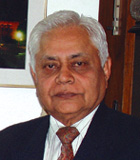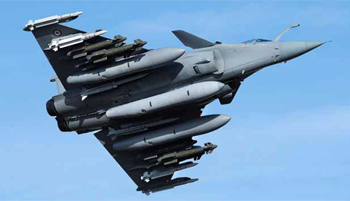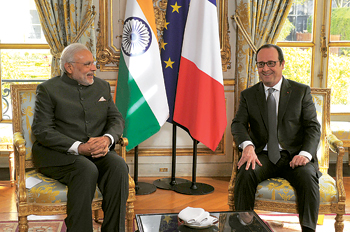INDIAN ARMED FORCES CHIEFS ON
OUR RELENTLESS AND FOCUSED PUBLISHING EFFORTS

SP Guide Publications puts forth a well compiled articulation of issues, pursuits and accomplishments of the Indian Army, over the years

I am confident that SP Guide Publications would continue to inform, inspire and influence.

My compliments to SP Guide Publications for informative and credible reportage on contemporary aerospace issues over the past six decades.
- Prime Minister witnesses 'Bharat Shakti' – a Tri-Services Firing and Manoeuvre Exercise in Pokhran, Rajasthan
- Interim Defence Budget 2024-25 — An Analysis
- Union Defence budget 2024
- Prime Minister Modi Commemorates Indian Navy Day in a Grand Ceremony
- Prime Minister Modi Flies in the LCA Tejas
- New Chapter in India-Italy Defence Ties
- Airpower beyond Boundaries
Finalise the Rafale contract

Delay in conclusion of the contract for Rafale jets will only lead to delay in the delivery schedule of the aircraft which in turn will aggravate problems for the IAF
Based on a review of the combat fleet carried out at the Air Headquarters (Air HQ) in 2001, the Indian Air Force (IAF) had assessed that it would need to induct at least six squadrons of lightweight fighter aircraft for the air defence role as the fleet of MiG-21 (Type 77), whose induction had begun in the mid-1960s, was fast approaching the end of its technical life and would have to be retired from service in the near future. However, it took six years and several major modifications to the Staff Qualitative Requirements (SQRs) drawn up by Air HQ before the proposal for the procurement of 126 not lightweight but heavier weight platform described as medium multi-role combat aircraft (MMRCA) was finalised. Proposal to procure the aircraft from foreign sources was accepted by the Ministry of Defence (MoD) after which the request for proposal (RFP) was floated in August 2007. Out of the six contenders who had responded to the RFP, the Rafale from Dassault Aviation of France was identified by the IAF on January 31, 2012, as the preferred platform. However, the insurmountable roadblocks that were encountered during the contract negotiations proved to be the nemesis for the efforts by the IAF to sustain the operational potential of its combat fleet.
Breaking the Logjam


In April 2015, Prime Minister Narendra Modi broke the logjam when on a formal visit to France, in place of the troubled deal for 126 MMRCA, he personally engineered a $4.3-billion deal directly with the Government of France for the purchase of 36 Rafale jets in a flyaway condition. Soon after this came the announcement by the MoD that the tender for 126 Rafale MMRCA was cancelled. The trauma the IAF suffered on account of the failed tender for 126 aircraft was only partially alleviated by the inter-governmental agreement for the direct purchase of 36 Rafale jets. Against the requirement projected by Air HQ one-and-a-half decades ago for six squadrons of the Rafale MMRCA, the IAF will now have to settle for just two squadrons.
Contract Negotiations for 36 Rafale Jets
Since the new NDA Government came into power just over oneand-a-half years ago, initiation and finalisation of deals pertaining to military hardware during visits by the Prime Minister of India appears to have become a pattern. Apart from the initiation of the inter-governmental deal for 36 Rafale jets, finalisation of deals for the 22 AH-64E Apache attack helicopters and 15 of the CH-47F Chinook heavy-lift platforms as also for the manufacture in India of 200 of the Kamov Ka-226T, were finalised during the visit of Prime Minister Modi to the US and Russia respectively. It was therefore logical to expect that the contract for the 36 Rafale jets would be inked during the high profile visit of François Hollande, President of France, to India as the chief guest during the Republic Day parade at Delhi on January 26 this year and the related functions. There has been considerable speculation in the media about this possibility and a report to this effect appeared as recently as on December 26 last year.
As early as in May last year soon after Prime Minister Modi broke the logjam in the MMRCA tender and settled for direct purchase of 36 Rafale jets instead, the two sides decided to set up teams to work out the details in a time bound manner to facilitate signing of the contract as early as possible. However, no time frame was defined for the completion of contract negotiations. Eight months have gone by since the contract negotiations for 36 Rafale jets commenced, but the final word is yet to be said. From reports in the media it appears that while a number of issues have been resolved, the negotiations have got prolonged on account of differences primarily over two issues, namely the value of the contract and the level of offset obligations. Taking into account all the requirements projected by the IAF with regard to avionics, weapons integration as well as maintenance and product support packages, the cost of the deal is reported to have hit Rs. 65,000 crore ($10 billion) or more then Rs. 2000 crore per aircraft. This figure was the originally estimated value of the contract for 126 Rafale jets. As the negotiations in the MMRCA tender progressed, it is understood that the value of the deal for 126 Rafale jets had escalated to over $27 billion making it somewhat unaffordable for the nation. The second issue relates to offset obligations which as per the MoD ought to be fixed at 50 per cent of the value of the contract as was stipulated for the MMRCA tender for 126 aircraft. The French Government is reluctant to accept this level of offsets and would prefer it to be restricted to 30 per cent.
A report in the media dated January 14 has quoted the French Defence Minister Jean-Yves Le Drian as saying that the deal is yet to be finalised. The only inference from this statement is that the differences between the two sides still persist and the time frame for completion of the contract negotiations continues to remain uncertain. The chances for the contract being inked on the eve of Republic Day when the French President will be in Delhi, are therefore rather slim. Delay in conclusion of the contract will only lead to delay in the delivery schedule of the aircraft which will only serve to aggravate problems for the IAF.
Consequences of Delay
In the last 15 years, there has been radical change in the situation insofar as the combat fleet of the IAF is concerned. With the inevitable phasing out of the MiG-21, MiG-27 and Jaguar fleets over the next few years and presuming that the induction of 272 Su-30MKI will be completed by 2019, the IAF will be left with just 25 squadrons of combat aircraft as against the newly authorised strength of 42. Of these, the Mirage 2000 and the MiG-29 fleets, even with the ongoing upgrades, will be a generation behind and will not be able to serve as true frontline fighters. Besides, these fleets would have to be phased out in a decade or so. Induction of the 36 Rafale jets—two squadrons—however, will provide only partial relief to the combat fleet which is heading for a distressful situation as by the end of the current decade, the IAF is expected to be deficient by 15 squadrons or around 270 combat platforms. It goes without saying that the IAF will need to induct at least another 15 squadrons of the Rafale jets or combat aircraft of the same or next-generation and with similar or better capability if it has to maintain some sort operational edge over its inimical neighbours. With the pace at which the light combat aircraft (LCA) Tejas Mk I programme is progressing, the IAF would be hesitant to bank on this platform to pull its combat fleet out of the woods, assurances in this regard notwithstanding. Undoubtedly, the IAF is in serious difficulty and the challenges confronting it are daunting.





